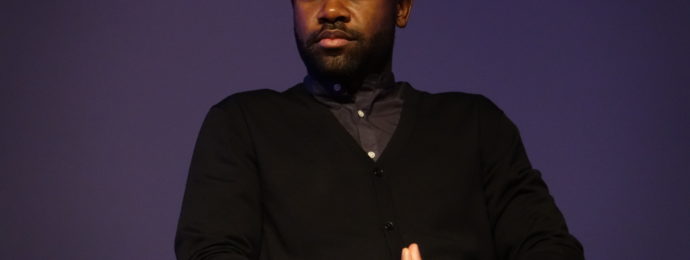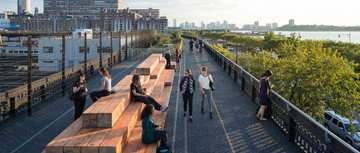The ceremony to mark the start of construction on the High Line – an elevated park built on part of an abandoned railroad line in Manhattan’s Lower West Side – about a decade ago was attended by a small number of architects, city officials and local cultural figures. One of the architects was Charles Renfro. Smartly dressed servers circulated among the guests, passing glasses of champagne from elegant trays. The atmosphere was celebratory, but Renfro couldn’t help but notice that the train tracks were still full of broken glass, cigarette butts and used condoms. He could smell urine everywhere, “and in the middle of it all we drank fancy champagne.” He looked at the guests and the champagne, and at the rough High Line, and thought that the High Line would only be a success if “we can preserve the wildness, the ruggedness, the authenticity of the rail line.”
Seven years after the High Line opened, the used condoms are gone and the park no longer smells of urine. But thanks to gentle, well-considered design, Renfro, Elizabeth Diller and Ricardo Scofidio – the partners in Diller Scofidio + Renfro – undoubtedly managed to preserve something of the toughness of the railway line and to turn the park into a major attraction.
In a city already full of architectural icons and places of interest, the High Line attracts seven million visitors a year – 6.4 million more than initial projections. Renfro himself, who lives above the High Line, admits to avoiding the park on weekends due to the crowds.
Visitors reach the elevated park through any of several stairways and elevators along its length. The park’s profusion of plants and variety of architectural elements – such as benches and railings – create a lively urban backdrop. A bleacher-like tiered wooden seating area on a bridge over 10th Avenue, in the southern part of the park, is nearly always crowded with people gazing through a transparent wall at the yellow cabs, limousines, police cruisers and pedestrians below.
This success took on an additional dimension when not only New Yorkers and tourists adopted the park as their own, but the High Line reciprocated, turning into a new artery for creativity and style. Every day at 5 P.M., for example, a resident of one of the apartments overlooking the park turns her balcony into a public stage for her opera singing.
The High Line is also a performance space for the visual arts, sound and visual installations, and virtually any creative endeavor imaginable.
Renfro, 51, says it offers “a new kind of public experience that uses the green [and] its surroundings,” but that its uniqueness comes from being elevated. “What people are open [to] is a super-charged public life,” he says.
The architect believes people living in cities have long been neglected. “The public has never been given respect, in a way, in design. For example, the first time we presented the glass rails for the park, the parks department says, ‘No way, these things are going to be busted, graffiti daubed in five minutes.’ After seven years of our first section being opened, none of that happened.
“We convinced them to make the lights sexy, low and elegant – like you would choose for an internal space, instead of these big lights. [Initially] they said, ‘No, you’re making a dangerous choice.’ [But] there hasn’t been any violent crime on the High Line. What I think is that the public is hungry for respect, [a] public space that treats them like sentient human beings and gives them an experience which challenges them to act on that,” adds Renfro.
Center of the margins
Our conversation takes place in Tel Aviv, immediately after Renfro delivered the keynote speech at the Israeli Green Building Council’s Annual Green Building and Smart Cities Conference, in late September. He is friendly, quick to smile and answers questions thoughtfully and at length. He is handsome and elegant, well-dressed and, belying the stereotype of the architect with an all-black wardrobe, seasons his look w高仿愛馬仕
ith unapologetic dashes of color.
After growing up in the small Texas city of Baytown – where he concealed his attraction to men and spent most of his childhood learning to play the clarinet and avoiding social activities – he says he has become a social animal who speaks with pride about being gay. Renfro often says he creates gay architecture that doesn’t try to be straight and carries its differentness proudly.
He is a frequent visitor to Tel Aviv, which is the hometown of his partner of several years, the acclaimed concert pianist Daniel Gortler. The pair live together in New York’s Garment District. They met at a New York gym, at a time when Renfro was beginning to wonder what kind of man would be willing to accept his busy, travel-filled life, and in which work occupied an outsized share of his time and energy. He found a musician who travels even more than he does and is equally devoted to his profession.
They often visit Tel Aviv together, and Renfro has come to know the city well. He will attend another conference next month, this time the Techno Art Conference at the Tel Aviv Museum of Art.
Diller Scofidio + Renfro, as it is now known, was founded in New York in 1979, and has become one of the most prominent names in contemporary architecture. The firm has designed some of the most talked-about public buildings of the last several years, including The Broad, a contemporary art museum in Los Angeles, and Boston’s Institute of Contemporary Art.
Scofidio, 81, whose family is of African-American heritage, founded the firm together with Diller, 62, a Polish Jew who immigrated to the United States with her family. The two met and fell in love when Scofidio was a professor and Diller a student. Renfro, who graduated from Rice University in Texas and received his master’s in architecture from New York’s Columbia University, joined the firm in 1997. Before that, he designed mainly interior spaces and taught architecture at a number of universities. In 2004, seven years after joining the firm, he became a partner and his name was added to the office.
The beginnings of the architectural studio were very different. Up until the 2000s, the firm designed very few buildings, focusing mainly on art installations. One of its best-known works was “Traffic” – in which 2,500 traffic cones were placed in New York’s Columbus Circle, for 24 hours in 1981, in a manner that didn’t disturb traffic.
But the project that marked the firm’s transition from art to pure architecture was the Blur Building, a media pavilion for the 2002 Swiss Expo. The firm’s next project is much better-known, and at the time surprised many people: the renovation of New York’s Lincoln Center, which was completed in two stages (in 2009 and 2010).
From there, the company began turning out projects at an ever-greater rate. In California alone, three projects were dedicated, and over the next two years two additional projects will be launched in Hudson Yards – the ambitious site where the end of the High Line is now under construction.
The three partners are also building Zaryadye Park in Moscow. Close to the Kremlin, it will be the first park to be built in the city for 50 years, and its location is highly symbolic: on the ruins of Hotel Rossiya, one of the biggest hotels in the world when it opened in 1969.
As a regular visitor to Tel Aviv, Renfro is ideally placed to pass judgment on its architecture. “Clearly, the Bauhaus culture and architecture is a lot of how you experience Tel Aviv,” he says, calling it “a modern city which is falling apart. The thing that always strikes me is how creative it is. My partner lives on a beautiful street with trees. The culture of Tel Aviv is slower and more considered. [With] the café culture here, there is always so much more pleasure felt. I attribute that to the way the city feels and how it operates economically; it’s a much more relaxing, sensual time.
“It is unfortunate that a lot of people that Daniel and I know leave Tel Aviv; it’s happening a lot,” he continues, cautioning the city to “keep your young people here and engaged. What I sense from just being here is that there are so many fantastic people – artists, intellectuals, architects, musicians. And yet when you look around at the city, it’s not the place [with] the best architecture, it’s not commensurate. There is work to be done. I love Tel Aviv and am excited to be here, and there is a great infrastructure that you can build and be the best city in the world. There’s so much potential, and I hope there has not been too much lost to realize this potential.”





